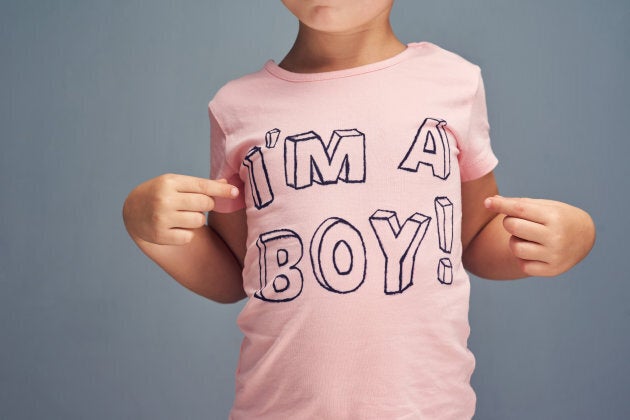The brain activity of transgender people matches that of the gender they want to live as, and not as the gender they were assigned at birth, according to a groundbreaking new study.
Researchers at the VU University Medical Center in the Netherlands examined the brain activity of 160 transgender people — including teenage boys and girls with gender dysphoria — using MRI scans.
They found that those who were assigned male at birth, but felt they were living in the wrong body, had brain structure and neurological patterns that were similar to those assigned female at birth. Similarly, they found that those who were assigned female at birth but were uncomfortable and experiencing distress with their assigned gender also had brain activity that was similar to those assigned male at birth.

The scientists who conducted research, which was recently presented at the European Society of Endocrinology's annual meeting in Barcelona, say their findings could be a useful tool to help youth experiencing gender dysphoria at a younger age, as this specific brain activity is detectable in childhood.
"The earlier it [being transgender] is detected, the better the outcome of the treatment," Prof. Julie Bakker, lead author of the study and an expert in neuroendocrinology at the University of Liege, told Newsweek.
"For instance in the Netherlands, youngsters are being treated with puberty inhibitors at 12 years of age to prevent the development of secondary sex characteristics which are difficult or even impossible to reverse (like the lowering of the voice in boys) and then at 16 years of age, they can start with cross-sex hormones. It has been shown that these youngsters are doing relatively well and are well accepted by their peers," she continued.

Dr. James Barrett, lead clinician at the Gender Identity Clinic, president of the British Association of Gender Identity Specialists and one of those who peer reviewed the study, noted that the research was good evidence that there's a clear link between the brains of transgender people and the gender they identify with.
"It used to be held long ago that all of this was psychological, and over the years the pendulum of 'Is it nature or nurture?' has swung rather more toward the nature side of it, with increasing peculiar pieces of biological evidence suggesting there may be something innate in the pre-uterine environment," he told Newsweek.
More from HuffPost Canada:
Speaking on the opinion held by some that being transgender is a choice, he said, "It is not the experience with the people I deal with on a day to day basis. I imagine they are the same people who say that gay people have a choice."
"Do people choose to be left-handed? You can make them write right-handed, and they can get quite good at it, but they'd be fundamentally left-handed. Why people are left-handed is a complicated business — but in the end, left-handed they are," he concluded.
What to do if your child says they're uncomfortable in their body
Transgender children are a controversial and difficult topic for parents. Not only are we unsure whether our child is in a "phase" but when our child is insistent that they're living in the wrong body, then we don't know whether we should let them decide when (or if) to start hormone therapy and at what age.
What we do know is that children develop their identity at a young age — before they reach three years old, most kids can label themselves as a boy or a girl and by the age of four, most of them have a clear sense of their gender identity.
We also know that it's critical for parents to support their children if they tell us they're uncomfortable in their bodies and/or feel they're in the wrong body.
The Human Rights Campaign reports that familial rejection can lead LGBTQ youth to engage in behaviours that put their health at risk, can trigger depression and other mental health problems, and can even result in homelessness or suicide.
The state of transgender people in Canada
Although there are no government statistics keeping track of the rates of violence, murder, homelessness or poverty faced by transgender Canadians, they face "constant" threat of violence, according to studies and advocates.
"We know trans people are one of the most targeted groups," Ryan Dyck, director of research, policy, and development at advocacy group Egale, told Global News in 2016. "And they experience violence at a much higher rate than other people."
The Trans Pulse Project surveyed 433 transgender Ontarians in 2015 and found that 20 per cent of them had been physically or sexually assaulted for being trans, and 67 per cent were worried they would die young.
And the 2015 Canadian Trans Youth Health Survey, which surveyed 923 trans youth across the country, found that 70 per cent of respondents said they had been sexually harassed and more than a third of participants aged 14 to 18 said they had been threatened or injured in the past year.

A 2017 survey found that safety, violence, and discrimination are big issues facing transgender youth in Alberta. More than 80 per cent of survey participants reported tensions with their families, 32 per cent reported running away from home, and 35 per cent reported incidents of threats or physical violence within the last year.
"Trans youth report significant stress and mental health challenges, a profound lack of safety in navigating their daily lives, barriers to supportive health care, and worrying rates of poverty," noted Kristopher Wells, principal author of the Alberta Trans Youth Health Survey and a professor in the University of Alberta's Department of Educational Policy Studies.
"We need to actively honour and listen to their voices and experiences when developing policies, training, and programs designed to address their health, safety, and educational needs," he added.
Attitudes towards transgender people are largely positive
A recent Ipsos survey suggests that internationally, including Canada, people are becoming more accepting of transgender people, but the majority of respondents believe governments should do more to protect them.
According to the survey, 70 per cent of respondents think their governments need to do more to protect trans people from discrimination, 69 per cent believe trans people should be allowed to get surgery so their body matches the gender they feel they are, and 61 per cent believe trans people should be allowed to serve in the military.
However, there was a notable disagreement over whether participants thought transgender people should be allowed to use the bathroom of the gender they identify with.
About 51 per cent of participants thought trans people should be allowed, while 36 per cent said they shouldn't, and 13 per cent weren't sure. In Canada, 61 per cent of respondents supported trans people using the bathroom of the gender they identified with, and 27 per cent of respondents were not.
Also on HuffPost: